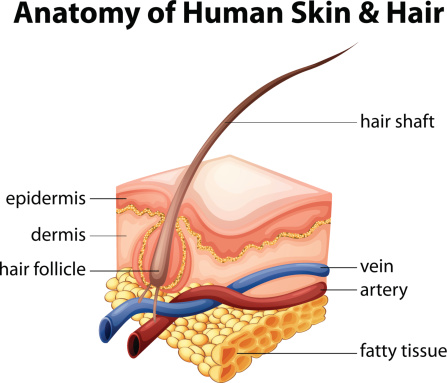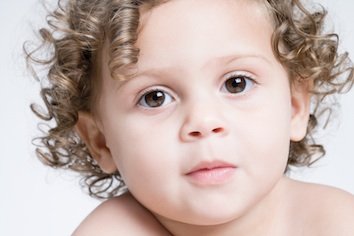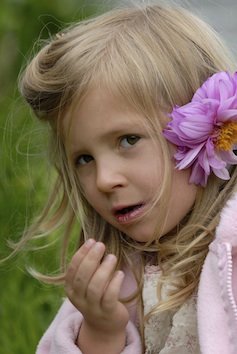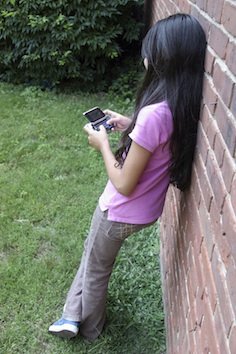Hair grows on our body.
Lots of hair grows on our head.
Some pople have straight hair.
Some people have curly hair.
Hair has different colours.
All mammals have hair, so because humans are mammals, we have hair.
Humans have very small, fine hairs over their bodies. Humans have hair over most of the body, but not on the soles of the feet, palms of the hand or lips.
Hair grows from under the skin Getty Images
Most of our hair is on our heads. We have millions of hairs on our head, and each hair grows about half a millimetre a day. Each day we lose 80 -100 hairs from our heads, but each is replaced.
Hair can be light or dark in colour, straight or curly. Getty Images
What is hair?
Hair is made of a protein called keratin (say keh-ruh-tin). Keratin is found in our nails, in horses' hooves, feathers, claws and antlers and a rhinoceros's horn is ALL HAIR. A strand of hair is made up of three main layers. The outer layer is called the cuticle, then comes the medulla and the outer layer is the cortex, which is where the keratin is found.
Did you know?
The most common hair colour is black!
Blonde hair grown slower than dark hair.
Hair stretches when it’s wet.
How does hair grow?
Curly hair grows from oval follicles. ©Getty
Each hair grows from a follicle, (say fol-ick-ill) which is a tiny opening in our scalp. If a person's follicles are round, their hair is straight. Curly hair grows from oval follicles. A chemical in your body called melanin gives your skin its colour, and also gives colour to your hair.
Straight hair grows from round follicles. ©Getty Images
If someone has very little melanin, their hair is very pale, someone with a bit more melanin has red hair. More melanin causes hair to be brown, and lots of melanin makes it black.
When people get older, they don't have as much melanin in their body, and so their hair becomes grey or even white.
Eyebrows and eyelashes protect the eyes from dirt, while the eyebrows also give protection from sweat.
Eyebrows can move and change shape to show how we are feeling. Look at yourself in a mirror to watch your eyebrows change shape when you look happy, surprised, angry!
Care for your hair
To keep hair healthy, we should eat foods such as eggs, salmon, carrots, and green vegetables.
Eating carrots is good for your hair. ©Getty Images
Washing your hair
Rub shampoo into your scalp and rinse well to keep hair clean. Getty Images
Rub shampoo into your scalp (head) and rinse well when washing your heair. Just rubbing shampoo onto hair can cause the hair to break. Wrap wet hair in a towel and pat dry to absorb the water. Rubbing wet hair with a towel can also damage hair.
About head lice and nits
Lice are tiny bugs that live in human hair close to the scalp. They feed on your blood and when they bite, it itches. Lice are very common especially on kids. They spread when kids put their head together and when you share combs or hats with others.
'Nits' are the eggs laid by female lice. They lay about 3 to 8 a day and firmly attached to hairs about 2 cm from the scalp. The warmth of the scalp helps them hatch.
Close up of a head louse. 'Nits' live on hair close to the scalp. Getty Images
Head lice eggs are oval, the size of a pin head. They are attached to hairs and cannot be brushed off.
Having lice doesn't mean you are dirty. Lice will live on hair whether it is clean or dirty. They are easy to get rid of by using a special shampoo and a fine comb
The affected person's pillowcase should be washed in hot water.
It’s a good idea to get information from more than one source!
The most common hair colour is black. ©Getty










